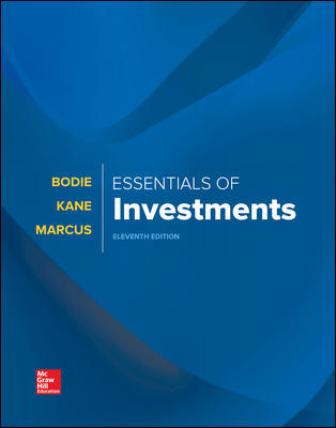Test Bank for Essentials of Investments, 11th Edition, Zvi Bodie, Alex Kane, Alan Marcus, ISBN10: 1260013928, ISBN13: 9781260013924
$55.00 Original price was: $55.00.$29.99Current price is: $29.99.
Test Bank for Essentials of Investments, 11th Edition, Zvi Bodie, Alex Kane, Alan Marcus, ISBN10: 1260013928, ISBN13: 9781260013924
Test Bank for Essentials of Investments, 11th Edition, Zvi Bodie, Alex Kane, Alan Marcus, ISBN10: 1260013928, ISBN13: 9781260013924

Product details:
- ISBN-10 : 1260013928
- ISBN-13 : 978-1260013924
- Author: Zvi Bodie
The market leading undergraduate investments textbook, Essentials of Investments by Bodie, Kane, and Marcus, emphasizes asset allocation while presenting the practical applications of investment theory. The authors have eliminated unnecessary mathematical detail and concentrate on the intuition and insights that will be useful to practitioners throughout their careers as new ideas and challenges emerge from the financial marketplace. The Eleventh Edition includes increased attention to changes in market structure and trading technology, while continuing to be organized around one basic theme – that security markets are nearly efficient.
Table contents:
- Part One: ELEMENTS OF INVESTMENTS
- Chapter 1 Investments: Background and Issues
- 1.1 Real Assets versus Financial Assets
- 1.2 Financial Assets
- 1.3 Financial Markets and the Economy
- The Informational Role of Financial Markets
- Consumption Timing
- Allocation of Risk
- Separation of Ownership and Management
- Corporate Governance and Corporate Ethics
- 1.4 The Investment Process
- 1.5 Markets Are Competitive
- The Risk-Return Trade-Off
- Efficient Markets
- 1.6 The Players
- Financial Intermediaries
- Investment Bankers
- Venture Capital and Private Equity
- 1.7 The Financial Crisis of 2008
- Antecedents of the Crisis
- Changes in Housing Finance
- Mortgage Derivatives
- Credit Default Swaps
- The Rise of Systemic Risk
- The Shoe Drops
- The Dodd-Frank Reform Act
- 1.8 Outline of the Text
- End-of-Chapter Material
- Chapter 2 Asset Classes and Financial Instruments
- 2.1 The Money Market
- Treasury Bills
- Certificates of Deposit
- Commercial Paper
- Bankers’ Acceptances
- Eurodollars
- Repos and Reverses
- Brokers’ Calls
- Federal Funds
- The LIBOR Market
- Yields on Money Market Instruments
- 2.2 The Bond Market
- Treasury Notes and Bonds
- Inflation-Protected Treasury Bonds
- Federal Agency Debt
- International Bonds
- Municipal Bonds
- Corporate Bonds
- Mortgage and Asset-Backed Securities
- 2.3 Equity Securities
- Common Stock as Ownership Shares
- Characteristics of Common Stock
- Stock Market Listings
- Preferred Stock
- Depositary Receipts
- 2.4 Stock and Bond Market Indexes
- Stock Market Indexes
- The Dow Jones Industrial Average
- The Standard & Poor’s 500 Index
- Other U.S. Market Value Indexes
- Equally Weighted Indexes
- Foreign and International Stock Market Indexes
- Bond Market Indicators
- 2.5 Derivative Markets
- Options
- Futures Contracts
- End-of-Chapter Material
- Chapter 3 Securities Markets
- 3.1 How Firms Issue Securities
- Privately Held Firms
- Publicly Traded Companies
- Shelf Registration
- Initial Public Offerings
- 3.2 How Securities are Traded
- Types of Markets
- Types of Orders
- Trading Mechanisms
- 3.3 The Rise of Electronic Trading
- 3.4 U.S. Markets
- NASDAQ
- The New York Stock Exchange
- ECNs
- 3.5 New Trading Strategies
- Algorithmic Trading
- High-Frequency Trading
- Dark Pools
- Bond Trading
- 3.6 Globalization of Stock Markets
- 3.7 Trading Costs
- 3.8 Buying on Margin
- 3.9 Short Sales
- 3.10 Regulation of Securities Markets
- Self-Regulation
- The Sarbanes-Oxley Act
- Insider Trading
- End-of-Chapter Material
- Chapter 4 Mutual Funds and Other Investment Companies
- 4.1 Investment Companies
- 4.2 Types of Investment Companies
- Unit Investment Trusts
- Managed Investment Companies
- Other Investment Organizations
- 4.3 Mutual Funds
- Investment Policies
- How Funds Are Sold
- 4.4 Costs of Investing in Mutual Funds
- Fee Structure
- Fees and Mutual Fund Returns
- 4.5 Taxation of Mutual Fund Income
- 4.6 Exchange-Traded Funds
- 4.7 Mutual Fund Investment Performance: A First Look
- 4.8 Information on Mutual Funds
- End-of-Chapter Material
- Part TWO: PORTFOLIO THEORY
- Chapter 5 Risk, Return, and the Historical Record
- 5.1 Rates of Return
- Measuring Investment Returns over Multiple Periods
- Conventions for Annualizing Rates of Return
- 5.2 Inflation and the Real Rate of Interest
- The Equilibrium Nominal Rate of Interest
- 5.3 Risk and Risk Premiums
- Scenario Analysis and Probability Distributions
- The Normal Distribution
- Normality and the Investment Horizon
- Deviation from Normality and Tail Risk
- Risk Premiums and Risk Aversion
- The Sharpe Ratio
- 5.4 The Historical Record
- Using Time Series of Returns
- Risk and Return: A First Look
- 5.5 Asset Allocation across Risky and Risk-Free Portfolios
- The Risk-Free Asset
- Portfolio Expected Return and Risk
- The Capital Allocation Line
- Risk Aversion and Capital Allocation
- 5.6 Passive Strategies and the Capital Market Line
- Historical Evidence on the Capital Market Line
- Costs and Benefits of Passive Investing
- End-of-Chapter Material
- Chapter 6 Efficient Diversification
- 6.1 Diversification and Portfolio Risk
- 6.2 Asset Allocation with Two Risky Assets
- Covariance and Correlation
- Using Historical Data
- The Three Rules of Two-Risky-Asset Portfolios
- The Risk-Return Trade-Off with Two-Risky-Assets Portfolios
- The Mean-Variance Criterion
- 6.3 The Optimal Risky Portfolio with a Risk-Free Asset
- 6.4 Efficient Diversification with Many Risky Assets
- The Efficient Frontier of Risky Assets
- Choosing the Optimal Risky Portfolio
- The Preferred Complete Portfolio and a Separation Property
- Constructing the Optimal Risky Portfolio: An Illustration
- 6.5 A Single-Index Stock Market
- Statistical Interpretation of the Single-Index Model
- Learning from the Index Model
- Using Security Analysis with the Index Model
- 6.6 Risk Pooling, Risk Sharing, and Time Diversification
- Time Diversification
- End-of-Chapter Material
- Chapter 7 Capital Asset Pricing and Arbitrage Pricing Theory
- 7.1 The Capital Asset Pricing Model
- The Model: Assumptions and Implications
- Why All Investors Would Hold the Market Portfolio
- The Passive Strategy Is Efficient
- The Risk Premium of the Market Portfolio
- Expected Returns on Individual Securities
- The Security Market Line
- Applications of the CAPM
- 7.2 The CAPM and Index Models
- 7.3 How Well Does the CAPM Predict Risk Premiums?
- 7.4 Multifactor Models and the CAPM
- The Fama-French Three-Factor Model
- Estimating a Three-Factor SML
- Multifactor Models and the Validity of the CAPM
- 7.5 Arbitrage Pricing Theory
- Diversification in a Single-Index Security Market
- Well-Diversified Portfolios
- The Security Market Line of the APT
- Individual Assets and the APT
- Well-Diversified Portfolios in Practice
- The APT and the CAPM
- Multifactor Generalization of the APT
- Smart Betas and Multifactor Models
- End-of-Chapter Material
- Chapter 8 The Efficient Market Hypothesis
- 8.1 Random Walks and Efficient Markets
- Competition as the Source of Efficiency
- Versions of the Efficient Market Hypothesis
- 8.2 Implications of the EMH
- Technical Analysis
- Fundamental Analysis
- Active versus Passive Portfolio Management
- The Role of Portfolio Management in an Efficient Market
- Resource Allocation
- 8.3 Are Markets Efficient?
- The Issues
- Weak-Form Tests: Patterns in Stock Returns
- Predictors of Broad Market Returns
- Semistrong Tests: Market Anomalies
- Strong-Form Tests: Inside Information
- Interpreting the Anomalies
- 8.4 Mutual Fund and Analyst Performance
- Stock Market Analysts
- Mutual Fund Managers
- So, Are Markets Efficient?
- End-of-Chapter Material
- Chapter 9 Behavioral Finance and Technical Analysis
- 9.1 The Behavioral Critique
- Information Processing
- Behavioral Biases
- Limits to Arbitrage
- Limits to Arbitrage and the Law of One Price
- Bubbles and Behavioral Economics
- Evaluating the Behavioral Critique
- 9.2 Technical Analysis and Behavioral Finance
- Trends and Corrections
- Sentiment Indicators
- A Warning
- End-of-Chapter Material
- Part THREE: DEBT SECURITIES
- Chapter 10 Bond Prices and Yields
- 10.1 Bond Characteristics
- Treasury Bonds and Notes
- Corporate Bonds
- Preferred Stock
- Other Domestic Issuers
- International Bonds
- Innovation in the Bond Market
- 10.2 Bond Pricing
- Bond Pricing between Coupon Dates
- Bond Pricing in Excel
- 10.3 Bond Yields
- Yield to Maturity
- Yield to Call
- Realized Compound Return versus Yield to Maturity
- 10.4 Bond Prices over Time
- Yield to Maturity versus Holding-Period Return
- Zero-Coupon Bonds and Treasury STRIPS
- After-Tax Returns
- 10.5 Default Risk and Bond Pricing
- Junk Bonds
- Determinants of Bond Safety
- Bond Indentures
- Yield to Maturity and Default Risk
- Credit Default Swaps
- 10.6 The Yield Curve
- The Expectations Theory
- The Liquidity Preference Theory
- A Synthesis
- End-of-Chapter Material
- Chapter 11 Managing Bond Portfolios
- 11.1 Interest Rate Risk
- Interest Rate Sensitivity
- Duration
- What Determines Duration?
- 11.2 Passive Bond Management
- Immunization
- Cash Flow Matching and Dedication
- 11.3 Convexity
- Why Do Investors Like Convexity?
- 11.4 Active Bond Management
- Sources of Potential Profit
- Horizon Analysis
- An Example of a Fixed-Income Investment Strategy
- End-of-Chapter Material
- Part FOUR: SECURITY ANALYSIS
- Chapter 12 Macroeconomic and Industry Analysis
- 12.1 The Global Economy
- 12.2 The Domestic Macroeconomy
- Gross Domestic Product
- Employment
- Inflation
- Interest Rates
- Budget Deficit
- Sentiment
- 12.3 Interest Rates
- 12.4 Demand and Supply Shocks
- 12.5 Federal Government Policy
- Fiscal Policy
- Monetary Policy
- Supply-Side Policies
- 12.6 Business Cycles
- The Business Cycle
- Economic Indicators
- Other Indicators
- 12.7 Industry Analysis
- Defining an Industry
- Sensitivity to the Business Cycle
- Sector Rotation
- Industry Life Cycles
- Industry Structure and Performance
- End-of-Chapter Material
- Chapter 13 Equity Valuation
- 13.1 Valuation by Comparables
- Limitations of Book Value
- 13.2 Intrinsic Value versus Market Price
- 13.3 Dividend Discount Models
- The Constant-Growth DDM
- Stock Prices and Investment Opportunities
- Life Cycles and Multistage Growth Models
- Multistage Growth Models
- 13.4 Price–Earnings Ratios
- The Price–Earnings Ratio and Growth Opportunities
- P/E Ratios and Stock Risk
- Pitfalls in P/E Analysis
- Combining P/E Analysis and the DDM
- Other Comparative Valuation Ratios
- 13.5 Free Cash Flow Valuation Approaches
- Comparing the Valuation Models
- The Problem with DCF Models
- 13.6 The Aggregate Stock Market
- End-of-Chapter Material
- Chapter 14 Financial Statement Analysis
- 14.1 The Major Financial Statements
- The Income Statement
- The Balance Sheet
- The Statement of Cash Flows
- 14.2 Measuring Firm Performance
- 14.3 Profitability Measures
- Return on Assets
- Return on Capital
- Return on Equity
- Financial Leverage and ROE
- Economic Value Added
- 14.4 Ratio Analysis
- Decomposition of ROE
- Turnover and Asset Utilization
- Liquidity Ratios
- Market Price Ratios
- Choosing a Benchmark
- 14.5 An Illustration of Financial Statement Analysis
- 14.6 Comparability Problems
- Inventory Valuation
- Depreciation
- Inflation and Interest Expense
- Fair Value Accounting
- Quality of Earnings and Accounting Practices
- International Accounting Conventions
- 14.7 Value Investing: The Graham Technique
- End-of-Chapter Material
- Part FIVE: DERIVATIVE MARKETS
- Chapter 15 Options Markets
- 15.1 The Option Contract
- Options Trading
- American and European Options
- The Option Clearing Corporation
- Other Listed Options
- 15.2 Values of Options at Expiration
- Call Options
- Put Options
- Options versus Stock Investments
- 15.3 Option Strategies
- 15.4 Optionlike Securities
- Callable Bonds
- Convertible Securities
- Warrants
- Collateralized Loans
- Leveraged Equity and Risky Debt
- 15.5 Exotic Options
- Asian Options
- Currency-Translated Options
- Digital Options
- End-of-Chapter Material
- Chapter 16 Option Valuation
- 16.1 Option Valuation: Introduction
- Intrinsic and Time Values
- Determinants of Option Values
- 16.2 Binomial Option Pricing
- Two-State Option Pricing
- Generalizing the Two-State Approach
- Making the Valuation Model Practical
- 16.3 Black-Scholes Option Valuation
- The Black-Scholes Formula
- The Put-Call Parity Relationship
- Put Option Valuation
- 16.4 Using the Black-Scholes Formula
- Hedge Ratios and the Black-Scholes Formula
- Portfolio Insurance
- Option Pricing and the Crisis of 2008–2009
- 16.5 Empirical Evidence
- End-of-Chapter Material
- Chapter 17 Futures Markets and Risk Management
- 17.1 The Futures Contract
- The Basics of Futures Contracts
- Existing Contracts
- 17.2 Trading Mechanics
- The Clearinghouse and Open Interest
- Marking to Market and the Margin Account
- Cash versus Actual Delivery
- Regulations
- Taxation
- 17.3 Futures Market Strategies
- Hedging and Speculation
- Basis Risk and Hedging
- 17.4 Futures Prices
- Spot-Futures Parity
- Spreads
- 17.5 Financial Futures
- Stock-Index Futures
- Foreign Exchange Futures
- Interest Rate Futures
- 17.6 Swaps
- Swaps and Balance Sheet Restructuring
- The Swap Dealer
- End-of-Chapter Material
- Part SIX: ACTIVE INVESTMENT MANAGEMENT
- Chapter 18 Evaluating Investment Performance
- 18.1 The Conventional Theory of Performance Evaluation
- Average Rates of Return
- Time-Weighted Returns versus Dollar-Weighted Returns
- Adjusting Returns for Risk
- Risk-Adjusted Performance Measures
- The Sharpe Ratio for Overall Portfolios
- The Treynor Ratio
- The Information Ratio
- The Role of Alpha in Performance Measures
- Implementing Performance Measurement: An Example
- Selection Bias and Portfolio Evaluation
- 18.2 Style Analysis
- 18.3 Morningstar’s Risk-Adjusted Rating
- 18.4 Performance Measurement with Changing Portfolio Composition
- 18.5 Market Timing
- The Potential Value of Market Timing
- Valuing Market Timing as a Call Option
- The Value of Imperfect Forecasting
- 18.6 Performance Attribution Procedures
- Asset Allocation Decisions
- Sector and Security Selection Decisions
- Summing Up Component Contributions
- End-of-Chapter Material
- Chapter 19 International Diversification
- 19.1 Global Markets for Equities
- Developed Countries
- Emerging Markets
- Market Capitalization and GDP
- Home-Country Bias
- 19.2 Exchange Rate Risk and International Diversification
- Exchange Rate Risk
- Imperfect Exchange Rate Risk Hedging
- Investment Risk in International Markets
- International Diversification
- Are Benefits from International Diversification Preserved in Bear Markets?
- 19.3 Political Risk
- 19.4 International Investing and Performance Attribution
- Constructing a Benchmark Portfolio of Foreign Assets
- Performance Attribution
- End-of-Chapter Material
- Chapter 20 Hedge Funds
- 20.1 Hedge Funds versus Mutual Funds
- 20.2 Hedge Fund Strategies
- Directional versus Nondirectional Strategies
- Statistical Arbitrage
- 20.3 Portable Alpha
- An Example of a Pure Play
- 20.4 Style Analysis for Hedge Funds
- 20.5 Performance Measurement for Hedge Funds
- Liquidity and Hedge Fund Performance
- Hedge Fund Performance and Selection Bias
- Hedge Fund Performance and Changing Factor Loadings
- Tail Events and Hedge Fund Performance
- 20.6 Fee Structure in Hedge Funds
- End-of-Chapter Material
- Chapter 21 Taxes, Inflation, and Investment Strategy
- 21.1 Saving for the Long Run
- A Hypothetical Household
- The Retirement Annuity
- 21.2 Accounting for Inflation
- A Real Savings Plan
- An Alternative Savings Plan
- 21.3 Accounting for Taxes
- 21.4 The Economics of Tax Shelters
- A Benchmark Tax Shelter
- The Effect of the Progressive Nature of the Tax Code
- 21.5 A Menu of Tax Shelters
- Defined Benefit Plans
- Defined Contribution Plans
- Individual Retirement Accounts
- Roth Accounts with the Progressive Tax Code
- Risky Investments and Capital Gains as Tax Shelters
- Sheltered versus Unsheltered Savings
- 21.6 Social Security
- 21.7 Large Purchases
- 21.8 Home Ownership: The Rent-versus-Buy Decision
- 21.9 Uncertain Longevity and Other Contingencies
- 21.10 Matrimony, Bequest, and Intergenerational Transfers
- End-of-Chapter Material
- Chapter 22 Investors and the Investment Process
- 22.1 The Investment Management Process
- 22.2 Investor Objectives
- Individual Investors
- Professional Investors
- Life Insurance Companies
- Non-Life-Insurance Companies
- Banks
- Endowment Funds
- 22.3 Investor Constraints
- Liquidity
- Investment Horizon
- Regulations
- Tax Considerations
- Unique Needs
- 22.4 Investment Policies
- Top-Down Policies for Institutional Investors
- Active versus Passive Policies
- 22.5 Monitoring and Revising Investment Portfolios
- End-of-Chapter Material
- Appendixes
- A References
- B References to CFA Questions
- Index
People also search:
essentials of investments answers
essentials of a good plan
essential or essentials
essential foods to eat everyday
essential things for hair











